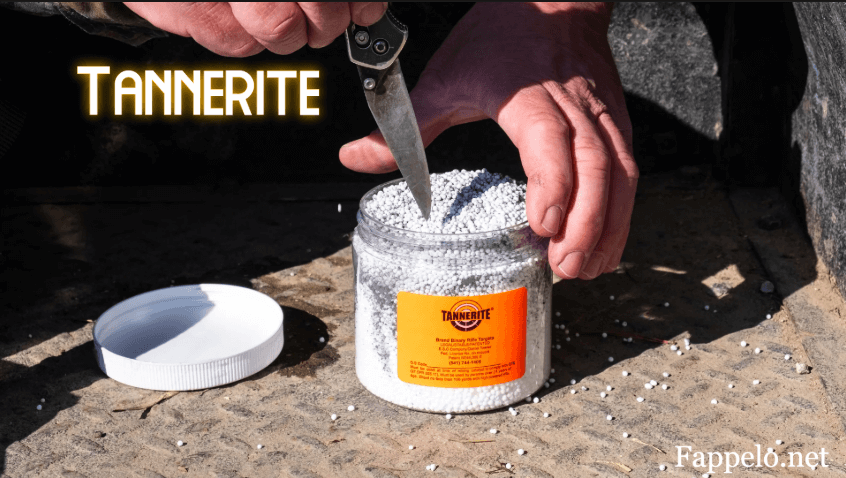Introduction
Tannerite has become a household name among shooting enthusiasts, often featured in viral videos where targets explode with dramatic flair.
But beyond the hype lies a highly engineered, binary explosive that has specific uses, legal limitations, and safety protocols.
In this article, we’ll explore what Tannerite is made of, how it works, its uses in recreational shooting, and the critical safety and legal guidelines that surround it.
Whether you’re a gun enthusiast, outdoor hobbyist, or simply curious, this guide offers everything you need to know.
Understanding Tannerite

What Is Tannerite Made Of?
Tannerite is a binary explosive, meaning it consists of two separate components that are inert on their own but become explosive when mixed:
- Ammonium Nitrate (oxidizer)
- Aluminum Powder (fuel)
These components are sold separately and are only reactive once combined in specific ratios—typically 95% ammonium nitrate and 5% aluminum powder.
How Does Tannerite Work?
Once mixed, Tannerite remains stable under most conditions but can be detonated by a high-velocity rifle round (typically over 2,000 feet per second). Unlike fireworks or other low-order explosives, it requires a precise kinetic trigger, which contributes to its reputation for safety when used correctly.
Tannerite in Recreational Shooting
Why Is Tannerite So Popular Among Shooters?
- Visual Confirmation: The explosion gives immediate confirmation of a hit, ideal for long-range shooting.
- Safe to Handle (Unmixed): Since the components are non-explosive separately, transportation and storage are safer than with other explosives.
- Legal to Purchase in Most States: No ATF permit is required for personal, non-commercial use in many U.S. jurisdictions.
Common Recreational Uses
- Long-range target shooting
- Competitive shooting sports
- Gender reveal parties (though highly discouraged due to safety)
- Filmmaking and effects (limited, often under regulation)
Safety Guidelines for Using Tannerite
Despite its controlled nature, misuse can lead to serious injury or even death. Follow these critical safety precautions:
1. Distance Is Crucial
Recommended distance from the target is 100 yards or more for small quantities (1 pound or less). Larger amounts require significantly greater distances.
2. Use in Open, Isolated Areas
Avoid using Tannerite in residential or forested areas due to fire and shockwave risks. Wide, open fields are best.
3. Protective Gear and Eye Safety
Always wear protective eyewear and ear protection. Debris from the explosion can travel further than expected.
4. Never Modify or Combine with Other Materials
Mixing Tannerite with other chemicals or substances is extremely dangerous and illegal. Keep it pure.
5. Weather Awareness
Avoid using Tannerite in dry conditions or during fire bans, especially in wildfire-prone areas.
Tannerite and the Law
Federal Laws in the U.S.
- Legal Status: Tannerite is legal under federal law because it is inert until mixed.
- ATF Oversight: The Bureau of Alcohol, Tobacco, Firearms, and Explosives (ATF) does not regulate binary explosives for personal use unless they are mixed in advance or stored post-mixing.
State and Local Restrictions
Some states and municipalities have enacted stricter laws:
| State | Restrictions |
| California | Regulated as an explosive under state law |
| New York | Banned for personal use |
| Maryland | Restricted use; some counties prohibit it |
| New Jersey | Requires an explosives license |
| Washington | Use limited during the fire season |
Transport and Storage
- Do not transport mixed Tannerite
- Store in cool, dry locations
- Avoid storing large quantities at home to prevent legal and safety issues
The Controversy Around Tannerite
Notable Incidents
- Forest Fires: Several wildfires have been directly linked to Tannerite misuse, including the 2017 Sawmill Fire in Arizona, which burned 47,000+ acres.
- Injury Cases: Reports exist of people losing limbs due to standing too close or using too much of the compound.
Public Perception and Media Portrayal
While advocates hail it as a safe, legal tool for responsible shooters, critics raise concerns about its accessibility and misuse, especially with rising incidents involving property damage or public disturbances.
Best Practices for Responsible Tannerite Use
To remain both legal and safe:
- Start small: Use half-pound targets for practice.
- Read the label: Only buy from reputable suppliers with clear usage guidelines.
- Notify neighbors: Avoid misunderstandings and complaints.
- Clean up: Debris from the explosion can be sharp or toxic if left behind.
Expert Opinions on Tannerite
“Tannerite is a great training and recreational tool—but like any explosive, it requires education and caution.”
says Daniel Cooper, firearms safety instructor and explosives technician.
“It’s not about banning it—it’s about creating awareness,”
adds Dr. Julia Hartford, a public safety consultant.
“We need to better educate users on the science and risks behind the boom.”
Tannerite in Commercial and Military Applications
Although best known for recreational use, Tannerite-like binary explosives have industrial relevance:
- Seismic Research: Controlled explosions to map geological layers
- Avalanche Control: Triggering snow movement in a safe, targeted manner
- Military Simulations: Replicating explosive sounds in training scenarios
These applications use different formulations but rely on the same principle of a stable, binary ignition system.
Environmental Concerns Related to Tannerite
Debris and Pollution
Explosions may scatter plastic containers and aluminum fragments into the environment.
Fire Risk
If used improperly, especially in dry areas, Tannerite can ignite fires that harm wildlife and natural resources.
Water Contamination
Though unlikely, residues can leach into the ground after repeated use in one area. Use discretion in sensitive environments.
Tannerite Compared to Other Explosive Targets
| Feature | Tannerite | Fireworks | Dynamite | Binary Kits (Generic) |
| Legality (Federal) | Legal | Legal (regulated) | Illegal without a license | Varies |
| Ease of Use | Easy | Moderate | Dangerous | Varies |
| Stability | High (unmixed) | Medium | Low | Depends |
| Detonation Method | High-velocity rifle | Fuse | Detonator | Varies |
| Main Use | Target practice | Celebration | Demolition | Similar to Tannerite |
Conclusion
Tannerite offers a safe, legal, and visually rewarding experience for target shooters when used responsibly.
But like any explosive, its power demands respect, awareness, and caution. As laws evolve and safety concerns grow, staying informed is the best way to enjoy Tannerite without crossing legal or ethical boundaries.
Whether you’re a weekend shooter or an outdoor sports enthusiast, this knowledge arms you with everything you need to use Tannerite safely, lawfully, and effectively.
FAQs
Is Tannerite legal in all 50 states?
No. While it’s federally legal, some states like California and New York restrict or ban its use. Always check local laws before purchasing or using.
Can Tannerite explode without being shot?
No. Tannerite requires a high-velocity impact (typically from a rifle) to detonate. It’s inert when unmixed or under normal conditions.
What happens if you mix Tannerite and store it?
Once mixed, it’s classified as an explosive and must be stored under ATF regulations. Storing mixed Tannerite at home is illegal and dangerous.
How much Tannerite can I use safely?
Experts recommend no more than 1 pound per target for personal use. Larger quantities require increased distance and safety measures.
Can Tannerite start a fire?
Yes. Especially in dry or grassy areas. Always check local fire risk levels before using.



